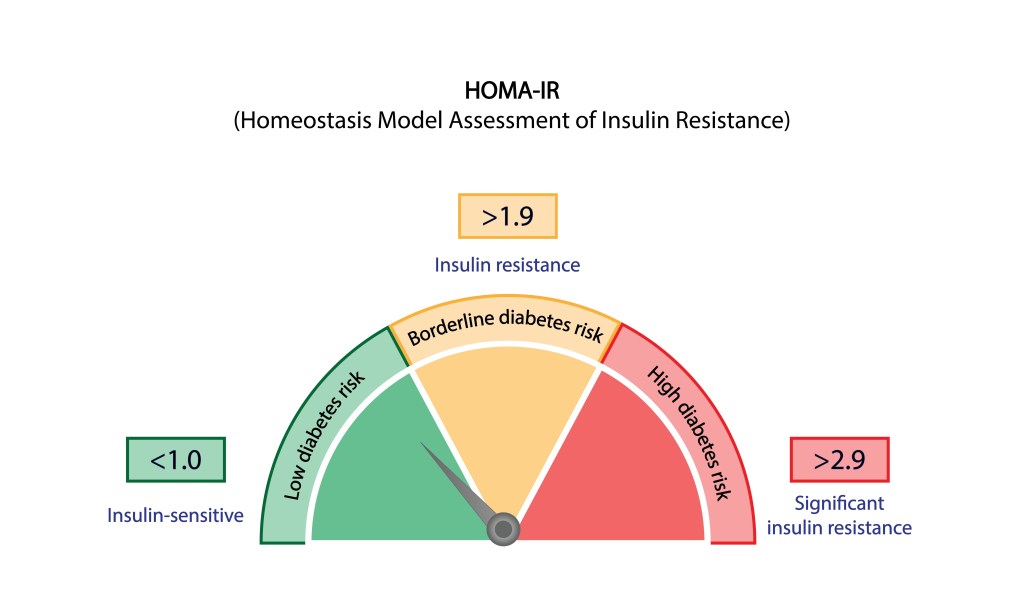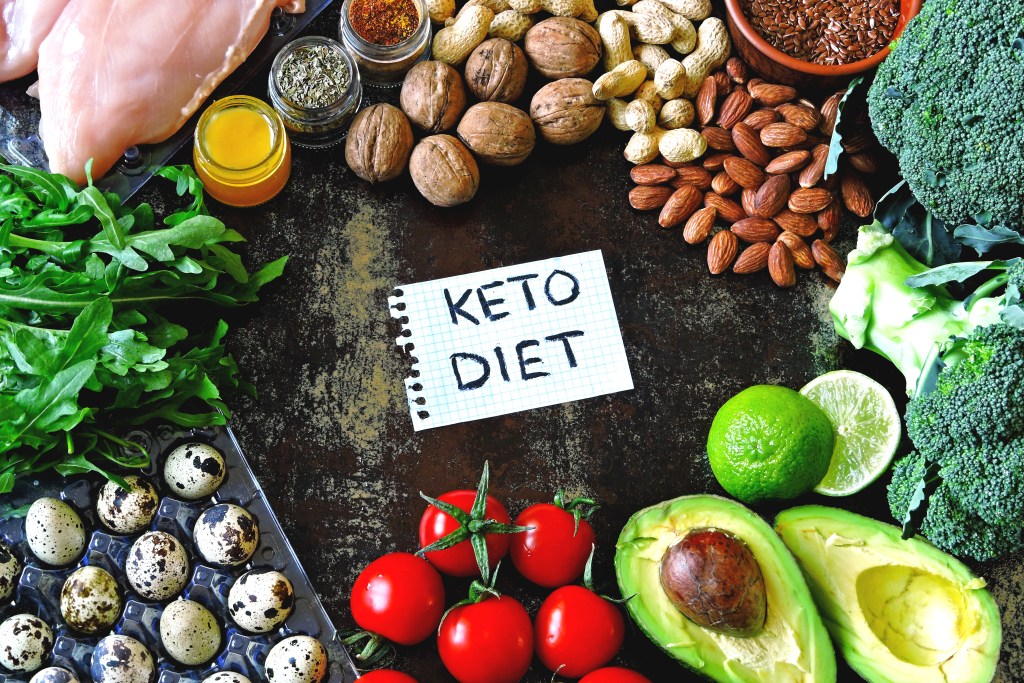At a glance
Insulin resistance occurs when the body’s cells become less responsive to insulin, leading to elevated blood sugar levels and potential metabolic complications. This condition is often associated with excessive carbohydrate intake, inactivity, and excessive body fat. Adopting a low-carb diet, managing stress, improving sleep, and practicing intermittent fasting can help support insulin sensitivity and promote better metabolic health..
Insulin resistance is a serious metabolic imbalance characterized by a progressive loss of blood sugar control, increasing the risk of developing diabetes.
Most cases of insulin resistance are linked to a high-carb diet and lack of physical activity. Making beneficial dietary and lifestyle changes is the key to managing and restoring metabolic health.
Here’s a complete guide to the symptoms and causes of insulin resistance and how to improve and restore blood sugar control.
What is insulin resistance?
Insulin is a critical metabolic hormone released by the pancreas in response to carbohydrate intake.
Insulin stimulates the cellular uptake of blood sugar, also known as blood glucose. This enables cells to convert blood sugar into energy and helps maintain normal blood glucose levels.
Insulin resistance refers to reduced cellular sensitivity to insulin signaling, resulting in chronically elevated blood sugar levels linked to various health issues such as diabetes, obesity, cardiovascular disease, high blood pressure, and metabolic syndrome.
Because elevated blood sugar levels are toxic to the body, the pancreas releases more insulin to compensate for inadequate cellular glucose uptake.
This creates a vicious cycle of high blood insulin levels, which can further desensitize cells, exacerbating insulin resistance and contributing to persistently high blood sugar levels.
In addition to its role in blood sugar control, insulin signals liver cells to convert excess blood sugar into fat. This explains why insulin-resistant individuals typically experience rapid weight gain.
Watch the video below to discover surprising facts about insulin.
Signs and symptoms
In most cases, insulin resistance develops slowly, with few early warning signs. As blood sugar control worsens, more metabolic pathways are impacted, which can lead to various symptoms.
Here are common signs and symptoms associated with insulin resistance syndrome:
- Weight gain
- Belly fat
- Sugar cravings
- Persistent hunger
- Sleepiness after meals
- Fatigue
- Increased thirst
- Frequent need to urinate at night
- High blood pressure
- Abnormal cholesterol levels
- Brain fog
- Blurred vision
- Fatty liver
Most cases of insulin resistance are diagnosed through blood tests indicating elevated fasting plasma glucose levels.
This is typically followed up with an oral glucose tolerance test to evaluate the body’s ability to process blood sugar levels, which helps identify and diagnose impaired insulin sensitivity.
Severe insulin resistance can have serious health consequences, including significant hormonal imbalances and organ damage. It’s crucial to consult a healthcare provider if you are worried about your metabolic health or show symptoms of insulin resistance.

Causes of insulin resistance
Regular consumption of sugars and carbohydrates and a lack of physical activity are the leading risk factors for insulin resistance.
Sugar and refined carbs cause rapid spikes in blood sugar levels, triggering insulin release. Regularly consuming high-carb foods can lead to chronically elevated insulin levels, which desensitizes cells to its effects, leading to insulin resistance.
Research published in Missouri Medicine confirms the link between carbohydrate consumption and the risk of developing insulin resistance. The authors summarize, “Starches and sugars increase fasting insulin levels, reduce insulin sensitivity, and reduce cellular insulin binding.”1
A sedentary lifestyle is associated with excess body fat, which has also been linked to poor blood sugar control.
Fat tissue, especially abdominal fat, produces adipokines, a group of hormone-like peptides that can trigger cellular inflammation. This can interfere with insulin signaling and contribute to insulin resistance.
In addition, individuals with a family history of diabetes and women who developed gestational diabetes during pregnancy are at increased risk of metabolic diseases, including insulin resistance.

Is it possible to reverse insulin resistance?
While there are no approved medications to treat insulin resistance, adopting a healthy diet low in carbohydrates and losing excess body weight can help reduce insulin resistance and restore metabolic health.
A study published in The Journal of Physiology found that even modest weight loss resulted in significantly enhanced insulin sensitivity and, in some cases, achieved complete reversal of insulin resistance.2
In addition, evidence published in International Scholarly Research Notices suggests that vitamin D, thiamine, chromium, and zinc play a crucial role in maintaining insulin sensitivity.3
This further highlights the importance of making beneficial dietary and lifestyle changes and prioritizing nutrient-dense whole foods to manage insulin resistance.

5 ways to improve insulin sensitivity
According to research published in The Journal of Clinical Endocrinology & Metabolism, more than 40 percent of U.S. adults have insulin resistance. This leaves a large part of the population at risk of diabetes, heart disease, and associated long-term health issues.4
Most healthcare providers suggest weight loss when treating insulin resistance. However, clear guidance on achieving a healthy body weight is often lacking, and patients struggle with sustainable lifestyle changes.
Luckily, there are several steps you can take to promote metabolic health.
1. Practice intermittent fasting
Intermittent fasting is an eating pattern alternating between fasting periods and time-restricted eating windows.
The 16:8 fasting method is a popular type of intermittent fasting that involves abstaining from food for 16 hours, followed by an 8-hour eating period.
Caloric restriction during fasting promotes steady blood glucose levels linked to balanced insulin production. Avoiding blood glucose and insulin spikes increases the body’s ability to process and absorb blood glucose, which is crucial in managing insulin resistance.
In addition, intermittent fasting is a highly effective weight-loss strategy, further benefiting those with insulin resistance.
Fasting depletes blood glucose and forces the body to utilize body fat to generate energy, which induces a metabolic state known as ketosis.
Ketosis can lead to rapid weight loss and promote the clearance of liver fat, often present in overweight or insulin-resistant individuals.
“Liver fat impairs the liver’s ability to process blood sugar and is a significant risk factor for insulin resistance,” explains Dr. Berg. “Intermittent fasting is one of the best therapeutic tools to enhance insulin sensitivity and improve blood sugar control.”
Research published in the International Journal of Endocrinology confirms the benefits of fasting for metabolic health. The study summarizes, “Intermittent fasting may improve glucose and lipid metabolism, as well as achieve significant weight loss and improve insulin resistance.”5

2. Follow Healthy Keto®
The benefits of time-restricted eating to manage insulin resistance can be amplified by combining intermittent fasting with a nutritious low-carb diet like Healthy Keto®.
Following a low-carb diet is crucial in improving and reversing insulin resistance. Keeping blood sugar and insulin levels balanced can help restore cellular responsiveness to insulin, which improves blood sugar control and reduces the risk of diabetes.
Limiting carb intake to no more than 50 grams daily pushes the body to burn fat, which keeps the body in ketosis even during eating windows.
This explains why combining intermittent fasting with a ketogenic diet can lead to significant weight loss, may help restore insulin resistance, and promote metabolic health.
Healthy Keto is a nutrient-dense ketogenic diet rich in whole foods. It’s an ideal meal plan for individuals with poor blood sugar control, including those with insulin resistance, prediabetes, and diabetes.
3. Prioritize sleep
A study published in Diabetes Care found that insufficient sleep can significantly increase the risk of insulin resistance, regardless of body weight.6
Poor sleep can lead to elevated levels of the stress hormone cortisol and reduced levels of growth hormone, both of which can impair cellular insulin sensitivity and contribute to insulin resistance.
Lack of sleep also triggers hunger and cravings, especially for energy-dense and high-carb foods that contribute to blood sugar imbalances and weight gain, exacerbating poor blood glucose control and metabolic imbalances.
However, it’s important to avoid popular sleeping aids, as they induce an unnatural state of sleep that has little to no metabolic benefits.
Instead, promote restful sleep with breathing exercises, practice good sleep hygiene, and create a calming bedtime routine that supports relaxation and a healthy sleep-wake cycle.

4. Reduce stress
Although it’s impossible to avoid stress, finding strategies to combat everyday stressors can play a vital role in supporting metabolic health and improving insulin balance.
Stress triggers the release of cortisol, a hormone that raises blood sugar levels to provide energy to sustain stressful periods. However, prolonged stress can lead to chronically elevated blood sugar and insulin levels, which can contribute to the development of insulin resistance.
Research published in Frontiers in Neuroendocrinology found that psychological stress can exacerbate hepatic insulin resistance and that stress-reduction techniques can help increase insulin sensitivity.7
Learning how to relax and prioritizing mental wellness can be an excellent strategy to reduce stress levels and improve insulin sensitivity.
5. Promote optimal nutrient levels
Healthy Keto offers a low-carb dietary approach focusing on nutrient-rich, high-quality foods, including non-GMO organic vegetables, grass-fed beef, full-fat organic dairy and eggs, and wild-caught fish.
This advanced version of the ketogenic diet promotes the body’s nutrient reserves and lowers the risk of deficiencies linked to poor blood sugar control and insulin resistance.
There are plenty of keto-approved foods rich in thiamine, also known as vitamin B1, magnesium, zinc, and copper, all of which play a role in blood glucose metabolism and insulin sensitivity.
In addition, vitamin D helps maintain cellular insulin sensitivity. A study published in Nutrients suggests that a lack of vitamin D is linked to an increased risk of metabolic imbalances, including insulin resistance.8
Getting enough sunshine exposure and consuming vitamin D-containing foods such as wild-caught salmon, sardines, egg yolks, and liver can support optimal vitamin D levels and promote balanced insulin function.
Key takeaways
- Insulin resistance is a metabolic condition that disrupts blood sugar control and may increase the risk of diabetes, heart disease, and metabolic syndrome.
- Diets high in sugars and refined carbohydrates are among the primary causes of insulin resistance.
- Combining a low-carb eating plan, such as Healthy Keto, with intermittent fasting can help prevent and potentially reverse insulin resistance.
- Supporting healthy sleep, managing stress, and eating nutrient-dense whole foods can further promote insulin sensitivity.
FAQ
1. What is insulin resistance?
Insulin resistance is a metabolic imbalance characterized by a loss of blood glucose control, leading to elevated blood sugar levels linked to an increased risk of diabetes, vision problems, and kidney diseases.
Poor dietary habits, a sedentary lifestyle, and excess weight are primary risk factors for developing insulin resistance.
2. What are the symptoms of insulin resistance?
There are very few signs and symptoms of insulin resistance during the early stages of this condition.
However, as the loss of blood sugar control progresses, common symptoms of insulin resistance include weight gain, hunger, sugar cravings, fatigue, increased thirst, frequent need to urinate at night, and high blood pressure.
3. Can you reverse insulin resistance?
Yes, reversing insulin resistance is possible by making beneficial dietary and lifestyle changes.
Limiting carbs and promoting healthy nutrient levels with a nutritious ketogenic diet, such as Healthy Keto® in combination with intermittent fasting, is a highly effective strategy to improve metabolic health and restore blood sugar control.
4. What foods cause insulin resistance?
A diet high in sugar and carbs is the main culprit of insulin resistance. These foods can cause excessive blood sugar and insulin levels, leading to cellular desensitization to insulin signaling.
Foods linked to insulin resistance include bread, pastry, cakes, crackers, flour, rice, pasta, sugars, syrups, candy, desserts, processed snack foods, fast foods, and sugar-laden soft drinks.
5. How do you lose weight if you have insulin resistance?
Insulin resistance causes a vicious cycle of weight gain and worsening blood sugar control.
However, combining intermittent fasting with a ketogenic diet pushes the body into ketosis. This metabolic state prioritizes fat-burning, which promotes weight loss, reduces insulin resistance, and improves blood sugar control.
6. Can insulin resistance turn into diabetes?
Yes, individuals who develop insulin resistance are at a high risk of progressing into prediabetes and diabetes.
However, beneficial dietary and lifestyle changes can help prevent the development of diabetes and may even help reverse insulin resistance.
Sources
- https://www.ncbi.nlm.nih.gov/pmc/articles/PMC9762218/ ?
- https://www.ncbi.nlm.nih.gov/pmc/articles/PMC2770158/ ?
- https://www.hindawi.com/journals/isrn/2012/103472/ ?
- https://www.ncbi.nlm.nih.gov/pmc/articles/PMC8684535/. ?
- https://www.ncbi.nlm.nih.gov/pmc/articles/PMC8970877/ ?
- https://diabetesjournals.org/care/article-abstract/47/1/117/153802/Chronic-Insufficient-Sleep-in-Women-Impairs ?
- https://www.sciencedirect.com/science/article/pii/S0091302221000741 ?
- https://www.ncbi.nlm.nih.gov/pmc/articles/PMC6520736/ ?


















